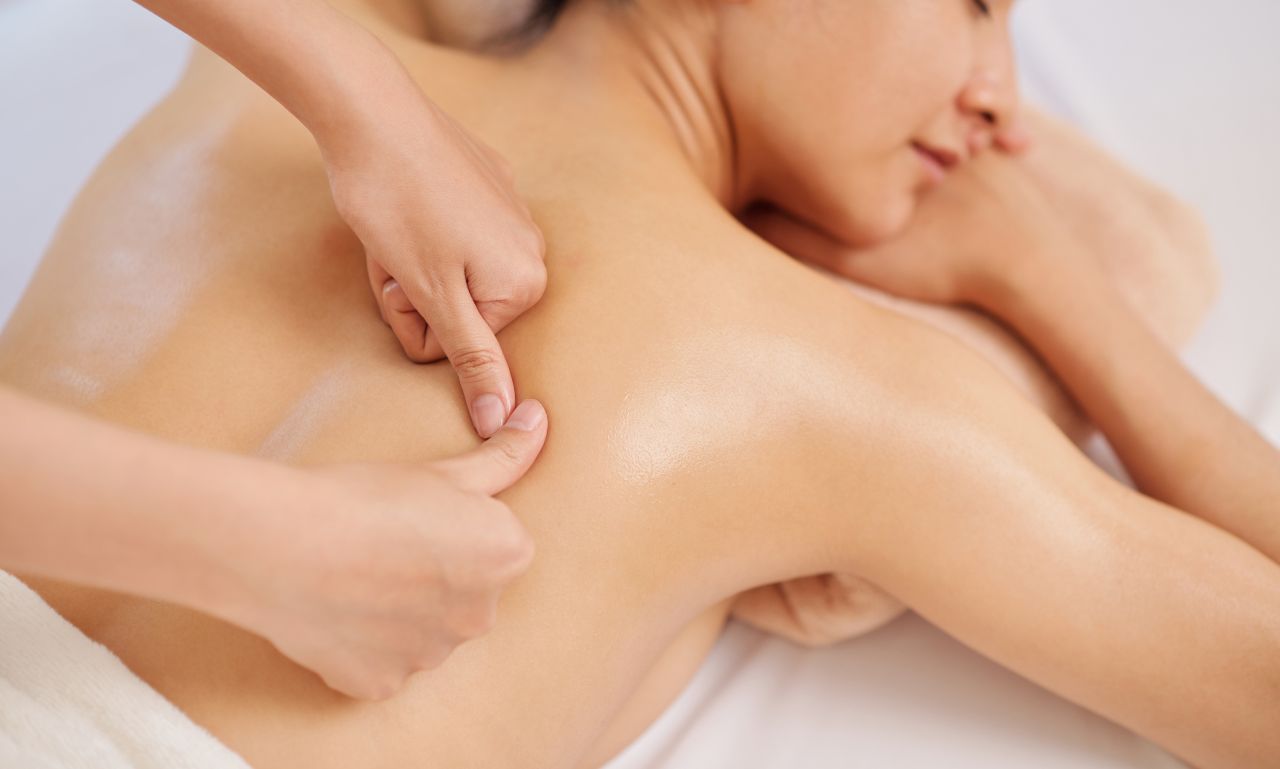Do you want to understand how deep-tissue massage helps your clients? Providing exceptional care requires massage therapists to deeply understand deep-tissue work, its methods, performance, and clinical implementations. Let us examine deep-tissue massage by analysing its advantages, essential therapist techniques, and vital client and therapist considerations. The time has come to increase your massage knowledge base to enhance your therapeutic practice.
What is Deep Tissue Massage?

Deep tissue massage is a therapeutic approach directing attention toward muscles and connective tissue layers in the body's deeper depths. It differs from Swedish massage because it targets chronic tension patterns while focusing on resolving particular muscle areas, which Swedish massage does not. Therapists effectively treat tough muscle knots by delivering deep and slow strokes with sustained pressure to eliminate pain and enhance muscle performance.
They perform firm pressure strokes during deep tissue massage to penetrate the body's deep muscle layers. They may use their forearms, elbows, or specialised tools to apply the necessary pressure and work through adhesions or scar tissue. The goal is to break up restrictive bands of tissue, increase blood flow, and promote healing in the affected areas.
Deep Tissue Massage vs Other Types of Massage
Deep tissue massage shares basic principles with other massage practices yet maintains its unique methodological characteristics. Here's a quick comparison:
- Swedish Massage: Gentle, relaxing strokes for overall tension relief and relaxation. It is ideal for stress reduction and promoting circulation.
- Sports Massage combines treatment strategies for sports-related injuries with techniques that enhance performance and facilitate post-activity recovery. It often incorporates deep tissue work.
- Trigger Point Therapy: The technique uses exact pressure on selected pain areas to reduce tension and manage pain that spreads through other body regions.
- Myofascial Release: Applying gentle yet sustained pressure allows therapists to release restrictions in fascial tissue surrounding muscles and internal organs.
Deep tissue massage specialists use market-modality techniques while concentrating their treatments on more profound muscle layers and connective tissues. This intense therapeutic method requires specialised training and comprehensive knowledge of anatomy and physiology.
Benefits of Deep Tissue Massage
The benefits of deep tissue massage extend far beyond simple relaxation. Here are some of the key advantages:
- Pain Relief: Deep tissue work can effectively alleviate pain in specific areas, such as the lower back, neck, and shoulders, by targeting chronic tension and knots.
- Improved Range of Motion: Releasing deep-seated tension and adhesions can help restore proper muscle function and improve flexibility and range of motion.
- Reduced Inflammation: Deep tissue massage promotes increased circulation and lymphatic drainage, which can help reduce inflammation and speed up the healing process.
- Stress Relief: Deep tissue massage creates intense feelings but simultaneously activates endorphin release, decreasing stress hormones to achieve relaxation and total well-being.
- Better Posture: Deep tissue massage techniques address problematic tension patterns, improve posture, and reduce the associated pain and dysfunction risk.
- Enhanced Athletic Performance: Deep tissue techniques help athletes recover from demanding workouts while reducing injury risks and achieving peak performance levels.
Historical Overview of the Deep Tissue Massage Technique
Deep tissue massage has roots in ancient healing practices, including traditional Chinese medicine and Ayurvedic massage. However, modern techniques were developed in the 20th century by pioneers like Therese Pfrimmer and Paul St. John.
Pfrimmer, a Canadian physiotherapist, developed deep muscle therapy in the 1940s to treat her paralysis. She would use deep, forceful pressure on targeted body regions to break tension while promoting healing processes.
American massage therapist St. John developed deep tissue techniques into the advanced form we recognise today during the 1970s and 1980s. He taught that therapists should use deep, slow strokes which follow the body's natural tissue structure to reach deep muscle layers.
Today, deep tissue massage is a widely recognised and valued modality taught in massage schools and practised by therapists worldwide. Its evolution continues as therapists combine deep tissue principles with other techniques to create a holistic, personalised approach to client care.
Tips For Performing Deep Tissue Massage

Deep tissue massage therapy demands professional expertise and personal wellness alongside intuitive abilities from massage therapists. Here are some essential tips:
- Warm Up the Tissue: Initiate your massage by applying gentle movements performed through sweeping motions to increase tissue temperature before moving on to strengthened specific techniques.
- Use Proper Body Mechanics: Protect your body by applying pressure using your body weight rather than just your hands. Keep your shoulders relaxed and your core engaged.
- Communicate with Your Client: Encourage open communication about pressure, discomfort, and problem areas. Be attentive to verbal and nonverbal cues.
- Focus on Problem Areas: Spend extra time on specific areas of tension or pain, using various techniques to release the tissue and promote relaxation.
- Stay Hydrated and Take Breaks: Deep tissue work can be physically demanding, so drink plenty of water and take breaks to avoid burnout.
- Practice Self-Care: Maintain physical and mental well-being through exercise, stretching, and stress-management techniques.
What to Expect During a Session?
Knowing what to expect during a deep tissue massage session can help clients feel more comfortable and get the most out of the experience. Here's a typical session breakdown:
- Consultation: The therapist will ask about the client's health history, current symptoms, and goals for the session.
- Positioning: The client will lie on a massage table, usually undressed to their comfort level and covered with a sheet or blanket.
- Warm-Up: The therapist will start with lighter pressure and broad strokes to warm up the muscles and assess the tissue.
- Targeted Work: Using various deep tissue techniques, the therapist will focus on specific areas of tension or pain, applying sustained pressure and slow, deep strokes.
- Communication: Throughout the session, the therapist will check in with the client about pressure and comfort levels, making adjustments as needed.
- Aftercare: The therapist will guide stretching, self-care, and potential side effects, such as temporary soreness or increased thirst.
Clients should communicate openly with their therapist, drink plenty of water after the session, and allow time for rest and recovery.
Who Can Benefit the Most?
Deep tissue massage can benefit many people, but it's particularly helpful for those with chronic pain, limited mobility, or high stress levels. Some specific groups who may benefit include:
- Athletes and fitness enthusiasts
- People with chronic pain conditions, such as fibromyalgia or osteoarthritis
- Office workers with postural strain or repetitive motion injuries
- Individuals recovering from injuries or surgeries
- Those dealing with high levels of stress or anxiety
However, deep tissue massage may not be suitable for everyone. Pregnant women, people with certain medical conditions, or those with acute injuries should consult with their healthcare provider before receiving deep tissue work.
Potential Side Effects and Considerations

While deep tissue massage is generally safe when performed by a trained therapist, there are some potential side effects and considerations to keep in mind:
- Soreness: It's common to feel soreness or tenderness in the treated areas for a day or two after a deep tissue session. This is a normal response to intense pressure and should subside independently.
- Bruising: In some cases, deep tissue work may cause slight bruising, especially in areas with thin skin or delicate tissue. This should heal within a few days.
- Increased Thirst: Deep tissue massage can stimulate the release of metabolic waste products, which may increase thirst. Drinking plenty of water after a session can help flush toxins and support healing.
- Emotional Release: Some people may experience an emotional release during or after a deep tissue session, as the work can tap into stored tension and memories. This is a normal response and can be part of the healing process.
Therapists should communicate these potential side effects to their clients and provide appropriate aftercare instructions. Clients should also inform their therapist of any discomfort, pain, or emotional reactions during the session.
How to Choose the Right Massage for Your Needs?
With so many massage modalities available, knowing which one is right for your specific needs can be challenging. Here are some factors to consider:
- Your Goals: Are you seeking general relaxation, pain relief, improved mobility, or stress reduction? Different massage styles target different goals.
- Your Comfort Level: Some people enjoy the intense pressure of deep tissue work, while others prefer a gentler touch. Consider your personal preferences and pain tolerance.
- Your Health Status: Some medical situations and injuries create specific restrictions on massage therapy choices. Let your therapist know about any health problems you have and get medical advice from your healthcare provider when necessary.
- Therapist Training: When selecting a therapist, verify their expertise in the specific modalities that appeal to you. Feel comfortable seeking answers about their credentialing and support techniques.
Tell your counsellor about your needs, preferred methods, and expected outcomes to get the best treatment for your requirements.
Conclusion
Through deep tissue massage therapy, individuals can achieve physical recovery and mental restoration, relieving pain while reducing stress. For effective personalised client care in massage therapy, it is essential for therapists to understand deep tissue techniques and their effects and applications.
As a deep tissue massage expert, you can enable your clients to reach their wellness objectives through pain relief, enhanced mobility, relaxation, and balance. If you combine your training in massage techniques with intuitive practice and prioritise self-care, you will develop a successful healing practice that benefits your clients substantially. Deep tissue massage power will bring client transformation to your practice as you learn and grow as a therapist.
Also Read: How to Reconstitute 5mg Semaglutide For Weight Loss




